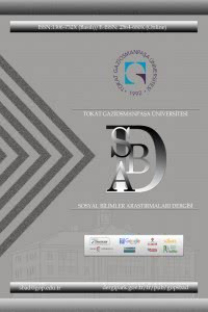YENİ GOTİK: DEHŞETİN YENİ ZEMİNİ OLARAK İNSAN ZİHNİ
İlk olarak yağmacı, vahşi toplulukları adlandırmak için kullanılan Got (goth, gothic) kelimesi zaman geçtikçe önce mimariye daha sonraysa edebiyata sıçramıştır. Karanlık ve kötücül olana dair olan hikâyeleri niteleyen bu kelime Gotik Edebiyat olarak kendine has bir tarza dönüşmüştür. 18. yüzyıldan Edgar Allan Poe‟ya dek Gotik Edebiyat doğaüstü güçleri yoğunlukla kullanmış ve açıklanamaz olayları kullanarak okurları arkaik korkularıyla yüzleştirmeye çalışmıştır. Poe ise insan psikolojisini de korkuya zemin hazırlayan faktörlerden biri olarak görmüş, bu nedenle doğaüstü güçlerle eşdeğer önem vermiştir. 20. yüzyıla gelindiğindeyse postmodern dönemin de etkisiyle doğaüstü bir kenara itilmiş, insan zihni ve psikolojisi dehşeti anlatmak için yeterli görülmüştür. Böylece, bir kısım yazar bu türden verdikleri eserlerle Yeni Gotik tarzının temsilcisi olmuşlardır. Bu makale, Yeni Gotik akımının özelliklerini öncülleriyle karşılaştırarak tartışmayı amaçlamaktadır
Anahtar Kelimeler:
Gotik, Yeni Gotik, Edgar Allan Poe, Patrick McGrath
THE NEW GOTHIC: HUMAN MIND AS A NEW GROUND FOR TERROR
The word Gothic, first used to name savage and pillaging communities, transferred to architecture and then literature. This word, which characterizes the stories about the dark and evil, has evolved into Gothic Literature. From the eighteenth century until Edgar Allan Poe, Gothic Literature intensely used the supernatural powers and tried to confront the readers with their archaic fears by using the inexplicable events. Poe, on the other hand, regards human psychology as one of the factors that set the ground for terror; that is why he pays equal importance to psychology along with supernatural powers. With the effect of the postmodern era in the twentieth century, the supernatural has been pushed to the edge, and human mind and psychology have become sufficient to describe terror. Hence, some authors have become representatives of the New Gothic style with their works. This article aims to discuss the characteristics of the New Gothic movement in comparison with its predecessors.
Keywords:
Gothic, New Gothic, Edgar Allan Poe, Patrick McGrath.,
___
- Aho, J. (2009). Body Matters: a Phenomenology of Sickness, Disease, and Illness. Plymouth: Lexington Books.
- Amis, M. (1992). Time's Arrow. New York: Vintage International.
- Botting, F. (2005). Gothic. New York: Routledge.
- Davenport-Hines, R. (2005). Gotik: Aşırılık, Dehşet, Kötülük ve Yıkımın Dört Yüz Yılı (H. Gür, Çev.). Ankara: Dost Kitabevi.
- Fiedler, L. A. (2003). Love and Death in the American Novel. Normal, IL: Dalkey Archive Press.
- Falco, M. (2001). The New Gothic in Patrick McGrath: An Uncanny Encounter. The Western Journal of Graduate Research,10(1), 15-26.
- Jenks, K. (2003). Transgression. New York: Routledge.
- Lima, M. (2010). Poe and Gothic Creativity. The Edgar Allan Poe Review, 11(1), 22-30.
- May, C. E. (2010). Edgar Allan Poe: Öykü Üzerine Bir İnceleme (H. Demir-Atay, Çev.). İstanbul: Boğaziçi Üniversitesi Yayınevi.
- McGrath, P. (1989). The Grotesque . New York: Vintage Books.
- Morrow, B. ve McGrath, P. (Ed.). (1993). The New Gothic. New York: Random House Value Publishing.
- Mull, Ç. P. (2008). Gotik Romanın Kıtalararası Serüveni. Ankara: Ürün Yayınları.
- Poe, E. A. (2007). Bu tu n Hikayeleri (D. Ko rpe, Çev.). I stanbul: I thaki Yayınları.
- Todorov, T. (2013). Fantastik. İstanbul: Metis Yayıncılık.
- Zlosnik, S. (2011). Patrick McGrath. Cardiff: University of Wales Press.
- ISSN: 1306-732X
- Yayın Aralığı: Yılda 2 Sayı
- Başlangıç: 2006
- Yayıncı: Gaziosmanpaşa Üniversitesi Sosyal Bilimler Enstitüsü
Sayıdaki Diğer Makaleler
OSMANLI BURSA’SINDA TÜCCAR LONCASI VAKFI VE KREDİ FAALİYETLERİ (1693-1823)
Mustafa Çolak, Komitenin Ruhu Talat Paşa, Yeditepe Yayınevi, İstanbul 2018.
HAYAT GÜZELDİR ESERĠ BAĞLAMINDA MUSTAFA KUTLU HĠKÂYESĠNDE KUġ VE ÇĠÇEK ĠMGESĠ
HAYAT GÜZELDİR ESERİ BAĞLAMINDA MUSTAFA KUTLU HİKÂYESİNDE KİÇEK İMGUŞVE ÇESİ
OSMANLI DÖNEMİNDE YAZILMIŞ BİR ASTRONOMİ ESERİ: MUVAKKİT MUSTAFA BİN ALİ’NİN TESHİLÜ’L-MİKAT’I
KAMU ÇALIŞANLARINDA FİNANSAL OKURYAZARLIK
BANKALARDA MÜLKİYET BAĞLAMINDA TAKİPTEKİ KREDİLER
Fatma YILDIZ, İBRAHİM HALİL EKŞİ, YUSUF BOZGEYİK, Ahmet KARAKUŞ
